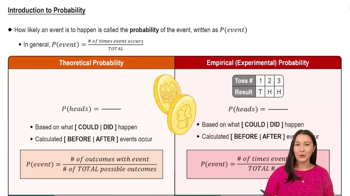25. Playlist A band is preparing a setlist of 21 songs for a concert. How many different ways can the band play the first six songs?
Table of contents
- 1. Intro to Stats and Collecting Data1h 14m
- 2. Describing Data with Tables and Graphs1h 55m
- 3. Describing Data Numerically2h 5m
- 4. Probability2h 16m
- 5. Binomial Distribution & Discrete Random Variables3h 6m
- 6. Normal Distribution and Continuous Random Variables2h 11m
- 7. Sampling Distributions & Confidence Intervals: Mean3h 23m
- Sampling Distribution of the Sample Mean and Central Limit Theorem19m
- Distribution of Sample Mean - Excel23m
- Introduction to Confidence Intervals15m
- Confidence Intervals for Population Mean1h 18m
- Determining the Minimum Sample Size Required12m
- Finding Probabilities and T Critical Values - Excel28m
- Confidence Intervals for Population Means - Excel25m
- 8. Sampling Distributions & Confidence Intervals: Proportion1h 12m
- 9. Hypothesis Testing for One Sample3h 29m
- 10. Hypothesis Testing for Two Samples4h 50m
- Two Proportions1h 13m
- Two Proportions Hypothesis Test - Excel28m
- Two Means - Unknown, Unequal Variance1h 3m
- Two Means - Unknown Variances Hypothesis Test - Excel12m
- Two Means - Unknown, Equal Variance15m
- Two Means - Unknown, Equal Variances Hypothesis Test - Excel9m
- Two Means - Known Variance12m
- Two Means - Sigma Known Hypothesis Test - Excel21m
- Two Means - Matched Pairs (Dependent Samples)42m
- Matched Pairs Hypothesis Test - Excel12m
- 11. Correlation1h 6m
- 12. Regression1h 50m
- 13. Chi-Square Tests & Goodness of Fit1h 57m
- 14. ANOVA1h 57m
4. Probability
Counting
Problem 3.4.37
Textbook Question
37. Water Pollution An environmental agency is analyzing water samples from 80 lakes for pollution. Five of the lakes have dangerously high levels of dioxin. Six lakes are randomly selected from the sample. Use technology to find how many ways one polluted lake and five nonpolluted lakes can be chosen.
 Verified step by step guidance
Verified step by step guidance1
Step 1: Understand the problem. We are tasked with finding the number of ways to select 1 polluted lake (out of 5) and 5 non-polluted lakes (out of 75) from a total of 80 lakes. This is a combination problem because the order of selection does not matter.
Step 2: Recall the formula for combinations, which is given by: , where n is the total number of items, and r is the number of items to choose.
Step 3: Calculate the number of ways to choose 1 polluted lake from the 5 polluted lakes using the combination formula: . This represents the number of ways to select 1 polluted lake.
Step 4: Calculate the number of ways to choose 5 non-polluted lakes from the 75 non-polluted lakes using the combination formula: . This represents the number of ways to select 5 non-polluted lakes.
Step 5: Multiply the results from Step 3 and Step 4 to find the total number of ways to select 1 polluted lake and 5 non-polluted lakes. The final expression is: .
 Verified video answer for a similar problem:
Verified video answer for a similar problem:This video solution was recommended by our tutors as helpful for the problem above
Video duration:
4mPlay a video:
Was this helpful?
Key Concepts
Here are the essential concepts you must grasp in order to answer the question correctly.
Combinatorics
Combinatorics is a branch of mathematics dealing with combinations and permutations of objects. In this context, it helps determine the number of ways to select a specific number of items from a larger set, which is essential for calculating how many ways one polluted lake and five nonpolluted lakes can be chosen from the sample.
Probability
Probability is the measure of the likelihood that an event will occur. Understanding probability is crucial in this scenario as it allows the environmental agency to assess the chances of selecting a polluted lake among the total lakes sampled, which informs risk assessments related to water pollution.
Recommended video:

Introduction to Probability
Sampling Techniques
Sampling techniques refer to the methods used to select a subset of individuals or items from a larger population. In this case, the random selection of lakes is a sampling technique that ensures each lake has an equal chance of being chosen, which is important for the validity of the analysis regarding pollution levels.
Recommended video:

Sampling Distribution of Sample Proportion

 7:11m
7:11mWatch next
Master Introduction to Permutations with a bite sized video explanation from Patrick
Start learningRelated Videos
Related Practice
Textbook Question
